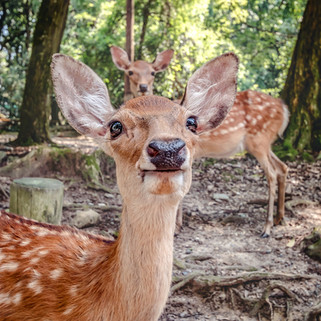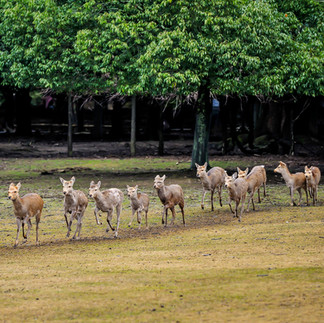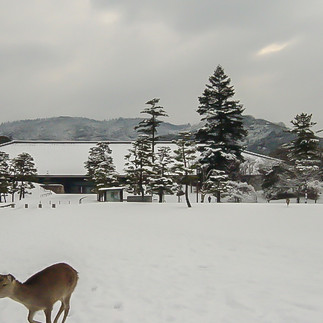NVC Walking Tours | Route E
- NVC

- Jul 30, 2021
- 5 min read
Updated: Jul 28
Learn The Secrets of The Deer of Nara
We have compiled some walking tours for our guests, leaving from NARA Visitor Center & Inn to some of the major sites around Nara and also some places and activities that might ordinarily fly under the radar.

Route E takes you from NARA Visitor Center & Inn, through Nara Park and into the grounds of Kasuga-Taisha Grand Shrine. Within the grounds of the shrine you will come across free roaming deer, The Man'yo Botanical Gardens and The Rokuen Deer Enclosure.
In this walking tour, we take a brief stop at the Rokeun Enclosure to learn about the deer and make a unique deer antler strap before continuing on to Kasuga-Taisha Grand Shrine.
The Rokuen Deer Enclosure
The deer of Nara park are designated a National Natural Treasure. There are over 1,200 deer roaming freely about the park and are accustomed to interacting with humans. The Rokuen Deer Enclosure is a shelter for Nara's deer operated by the Nara Deer Welfare Association.
It operates to protect the welfare of the deer, provide education on them (mainly to groups of visiting school children) and run official events involving the deer.
As the deer are kept safely behind fencing, the enclose is also a great place for smaller children to enjoy feeding the deer acorns without the worry of them getting hurt.
Kojika Koukai "Presentation of the Fawns"
After breeding season, the Rokuen gathers pregnant deer to keep in the enclosure to provide a safe environment for them to give birth. In the month of June, a special event called Kojika Koukai "Presentation of the Fawns" is held where the public can come and view the fawns in the enclosure.
Check out our visit to "Presentation of the Fawns" live streamed this summer.
Shikayose Deer Calling Event
Once the fawns are grown a little, they are released with their mothers into Nara park. Shortly after, every Sunday morning from mid July to mid September, an event is held called Shikayose "Deer Calling" in which a French horn player summons the local deer and newly born fawns to be fed with a performance of Beethoven's 6th Symphony Pastoral.
This free event is held at Tobihino, a nice expanse of green grass on the way to Kasuga Taisha. The area is also a great place to get some photos with the deer and you will often see wedding photos shoots here, too.
The Shikayose Deer Calling Event in also held in winter, occasionally against the backdrop of snow, which looks absolutely amazing.
Check out our visit to "Presentation of the Fawns" which was live streamed this summer in the video below.
Tsunokiri Deer Antler Cutting Event
Although deer are so accustomed to people that they will eat shika-senbei deer crackers out of your hand, come the October and November breeding season, the bucks (male deer) can become quite aggressive toward both each other and nearby people.
They can also cause damage to trees and property with their antlers. To prevent deer related injuries to residents and visitors, and damage to public and private property, Nara takes the necessary precaution of cutting off the deer’s antlers in a ceremony known as the Shika no Tsunokiri.
The Nara Magistrate conducted the first antler cutting ceremony in 1671, with consent from Kofuku-ji Temple, which was in charge of looking after the deer at the time. Initially, the ceremony took place all over Nara city and people used to watch the event from inside their fences or from their rooftops.
The duty of antler cutting was handed over to Kasuga Shrine in the 19th century but nowadays the task is carried out in cooperation with the Nara Deer Welfare Association at the Rokuen Deer Enclosure and the spectacle is open to the general public for a small fee. The fee goes to help with the upkeep of the Rokuen.
During the Shika no Tsunokiri, 4 buck deer are brought into the Rokuen’s oval-shaped field where they are chased and captured one-at-a-time by a group of 10 deer-wranglers called “seko”.
The seko use an X-shaped bamboo cross (“juji”) and a rope to snare the deer’s antlers. The rope is then wrapped around one of 2 wooden posts and the deer reeled in until the seko can subdue it and lay it down on a tatami mat cushion
Once the deer is captured a priest from Kasuga Shrine gives it water to calm it down and then saws its antlers off with a special saw. The deer is then released and the antlers offered to one of Kasuga Shrine’s deities.

While it may seem cruel, deer antlers are made of the same material as human fingernails and they fall out every winter and are replaced by new antlers in the spring.
The Shika no Tsunokiri takes place annually on the second weekend of October - a 3 day holiday weekend which includes the “Taiku no Hi” Sports Day holiday on Monday.
Five antler cutting sessions happen about every half-hour each day starting at 12:30pm. Admission is ¥1,000 for adults and ¥500 for children elementary school aged and younger.
Man'yo Botanical Gardens
Opening in 1932, the garden contains the over 300 species of plant which are mentioned in the Man'yoshu (Ten-Thousand Tanka: the oldest anthology of tanka poems, compiled sometime after AD 759 during the Nara period).
Each plant is labeled with its name and poems that mention it although at the time of writing, this labeling is in Japanese only.
The garden is most notable for its 20 varieties of wisteria which bloom magnificently during May. The wisteria is the symbol of the Fujiwara clan, who used to control much of Nara and were an integral part of the government of Japan from 710 to 1160.
The clan built Kasuga Taisha Grand Shrine in 768 and enshrined their guardian god here at the foot of Kasuga Hill. Their clan name, Fujiwara, incorporates the Chinese kanji character for wisteria. In Japanese, wisteria in pronounced "FUJI"
The garden is also home to the annual Man'yo Gagaku Performance Festival which is held in early November around the Japanese holiday of "Culture Day." The event takes place on the floating stage at the edge of the pond (as seen in our video) and includes traditional court dance and wind and string instrument performances passed down at Kasuga Taisha Shrine for generations.
Entrance to the garden costs ¥500 for adults and ¥250 for children.
Download the PDF overview of the walking tour.

*Exact times and dates of events may vary yearly. Please check the official websites.
Summer Shikayose | Winter Shikayose | Deer Antler Cutting | Man'yo Gagaku Performance




























Comments